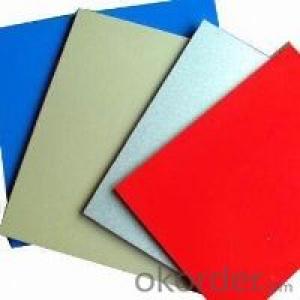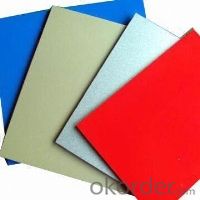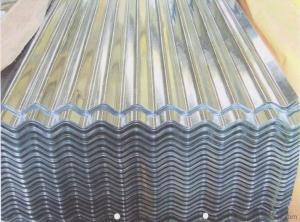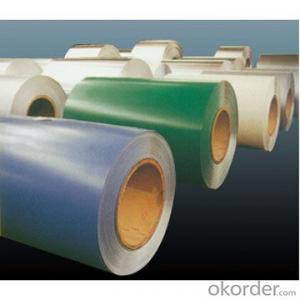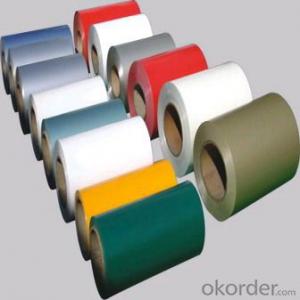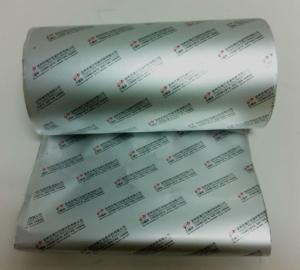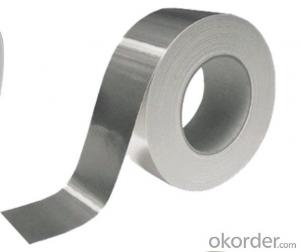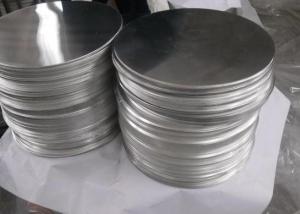Aluminum Pre Painted Aluminum Foil
- Loading Port:
- China Main Port
- Payment Terms:
- TT OR LC
- Min Order Qty:
- -
- Supply Capability:
- -
OKorder Service Pledge
OKorder Financial Service
You Might Also Like
We provide a full range of precision aluminum strip for almost any application. We produce aluminum strip in a wide variety of alloys, including clad composites. Our aluminum strip can be produced in standard dimensions or custom made to your special requirements. We produce both imperial and metric units. We manufacture in compliance with the main international specifications, and tighter tolerances or custom tempers are available upon request. We offer various surface conditions, custom finishes (painting, anodizing, embossing), special processing, and multiple packaging options to meet our customer's unique requirements. The following is a summary of our capabilities.
Manufactured in compliance with the main international specifications and standards, including: Aluminum Association, ASTM, EN, and DIN.
We can also manufacture in compliance with other international standards including:ASME, SAE, AMS, AWS, FED, MIL, QQ, ISO, BS, AFNOR, JIS and GOST.
Manufactured in compliance with the main international specifications and standards.
Tighter tolerances are available upon request.
Aluminium (or aluminum; see spelling differences) is a chemical element in the boron group with symbol Al and atomic number 13. It is a silvery white, soft, ductile metal. Aluminium is the third most abundant element (after oxygen and silicon), and the most abundant metal in the Earth's crust. It makes up about 8% by weight of the Earth's solid surface. Aluminium metal is so chemically reactive that native specimens are rare and limited to extreme reducing environments. Instead, it is found combined in over 270 different minerals.The chief ore of aluminium is bauxite.
Aluminium is remarkable for the metal's low density and for its ability to resist corrosion due to the phenomenon of passivation. Structural components made from aluminium and its alloys are vital to the aerospace industry and are important in other areas of transportation and structural materials. The most useful compounds of aluminium, at least on a weight basis, are the oxides and sulfates.
Despite its prevalence in the environment, no known form of life uses aluminium salts metabolically. In keeping with its pervasiveness, aluminium is well tolerated by plants and animals. Owing to their prevalence, potential beneficial (or otherwise) biological roles of aluminium compounds are of continuing interest.
Aluminium alloys with a wide range of properties are used in engineering structures. Alloy systems are classified by a number system (ANSI) or by names indicating their main alloying constituents (DIN and ISO).
The strength and durability of aluminium alloys vary widely, not only as a result of the components of the specific alloy, but also as a result of heat treatments and manufacturing processes. A lack of knowledge of these aspects has from time to time led to improperly designed structures and gained aluminium a bad reputation.
One important structural limitation of aluminium alloys is their fatigue strength. Unlike steels, aluminium alloys have no well-defined fatigue limit, meaning that fatigue failure eventually occurs, under even very small cyclic loadings. This implies that engineers must assess these loads and design for a fixed life rather than an infinite life.
Another important property of aluminium alloys is their sensitivity to heat. Workshop procedures involving heating are complicated by the fact that aluminium, unlike steel, melts without first glowing red. Forming operations where a blow torch is used therefore require some expertise, since no visual signs reveal how close the material is to melting. Aluminium alloys, like all structural alloys, also are subject to internal stresses following heating operations such as welding and casting. The problem with aluminium alloys in this regard is their low melting point, which make them more susceptible to distortions from thermally induced stress relief. Controlled stress relief can be done during manufacturing by heat-treating the parts in an oven, followed by gradual cooling—in effect annealing the stresses.
The low melting point of aluminium alloys has not precluded their use in rocketry; even for use in constructing combustion chambers where gases can reach 3500 K. The Agena upper stage engine used a regeneratively cooled aluminium design for some parts of the nozzle, including the thermally critical throat region.
Another alloy of some value is aluminium bronze (Cu-Al alloy).
Aluminium foil acts as a total barrier to light and oxygen (which cause fats to oxidise or become rancid), odours and flavours, moistness, and germs, it is used broadly in food and pharmaceutical packaging. The purpose of aluminium is to make long-life packs (aseptic processing|aseptic packaging) for drinks and dairy goods, which allows storing without refrigeration. Aluminium foil containers and trays are used to bake pies and to pack takeaway meals, ready snacks and long life pet foods.
Aluminium foil is widely sold into the consumer market, often in rolls of 500 mm (20 in) width and several metres in length.It is used for wrapping food in order to preserve it, for example, when storing leftover food in a refrigerator (where it serves the additional purpose of preventing odour exchange), when taking sandwiches on a journey, or when selling some kinds of take-away or fast food. Tex-Mex restaurants in the United States, for example, typically provide take-away burritos wrapped in aluminium foil.
Aluminium foils thicker than 25 μm (1 mil) are impermeable to oxygen and water. Foils thinner than this become slightly permeable due to minute pinholes caused by the production process.
- Q: I know about the protective layer of aluminium oxide from the reaction with oxygen but why does this stop it from rusting? Iron still rusts after forming a layer of iron oxide so why is aluminium oxide better protection? All that I can find is that iron oxide is crumbly which leaves other layers exposed which can then react but that doesn't explain why the iron oxide can then bond loosely with water.
- Aluminium has a high charge density 3+ It is also very small with a high charge to size ratio. Now if you stick something very electronegative such as oxygen next to a highly charged cation the bonds are going to be very strong. More energy is needed to break the bonds. Which is why it is quite unreactive. Covalent bonds form.
- Q: In building bicycle frames or other constructions, which require High Strength and Low Weight it is best to use builiding materials which are:A) Solid circular shaped rods made of steelB) solid triangular shaped rods made from aluminium alloyC) Hollow circular shaped rods made from aluminium alloyD) Flat pressed iron or aluminium
- It is actually really easy.just take a thin strip of foil and cover the crustYou will have to do this in about three or four sections.When the pie is about done remove foil so edges can get golden brown.
- Q: Somnething that is not to fancy but not to cheep lookingAny ideas?
- dont expose it to the foil, ideally it would be in a sealed glass container
- Q: i grew up in the mid-westi say TIN FOILsome people say ALUMINUM FOILwhat do you say? i wonder why the difference.
- Hypercholesterolemia may lead to coronary artery diseaseHypertriglyceridemia may lead to pancreatitisAdopt DASH diet (The Mediterranean diet)Also take Omega-3 fatty acid dailyEat a low-cholesterol, low-fat diet, which includes cottage cheese, fat-free milk, fish, vegetables, poultry, and egg whitesUse monounsaturated oils such as olive, peanut, and canola oils or polyunsaturated oils such as corn, safflower, soy, sunflower, cottonseed, and soybean oilsAvoid foods with excess fat in them such as meat (especially liver and fatty meat), egg yolks, whole milk, cream, butter, shortening, pastries, cakes, cookies, gravy, peanut butter, chocolate, olives, potato chips, coconut, cheese (other than cottage cheese), coconut oil, palm oil, and fried foods.
- Q: Is aluminum a suitable material for use in space exploration?
- <p>Yes, aluminum is indeed used in space exploration. It is valued for its lightweight properties, which are crucial for reducing the mass of spacecraft and payloads. Additionally, aluminum has good thermal conductivity and can withstand extreme temperature variations, making it suitable for various components in spacecraft. It is also resistant to corrosion and has high reflectivity, which can be beneficial for heat management and communication systems. However, its low strength-to-weight ratio compared to some other materials like titanium or advanced composites means it is often used in combination with other materials or for specific applications where its properties are advantageous.</p>
- Q: Are aluminum profiles suitable for automotive body panels?
- Yes, aluminum profiles are suitable for automotive body panels. Aluminum is a lightweight and durable material that has several advantages over traditional steel panels. It offers better fuel efficiency as it reduces the overall weight of the vehicle, leading to improved performance and lower emissions. Aluminum panels also have excellent corrosion resistance, which helps to prolong the lifespan of the vehicle. Moreover, aluminum is highly moldable and can be formed into complex shapes, making it suitable for creating the aerodynamic designs required in modern automotive styling. Additionally, aluminum is a recyclable material, aligning with the industry's growing focus on sustainability. However, it is important to note that aluminum panels may require specialized repair techniques compared to steel, and they can be more expensive to manufacture initially. Overall, the benefits of using aluminum profiles for automotive body panels outweigh the potential drawbacks, making them a suitable choice for modern vehicles.
- Q: with readers now being able to scam your credit card numbers from the cards in your wallet, can i use 2 pieces of lead sheets and stick the credit cards sandwiched between them to avoid getting scammed ???
- DenimBeautiful and long lasting.
- Q: Calculation method for material cost of aluminium bars
- All by the CM countRadius * radius *3.14*, length *0.00275... Units are converted to centimeters! All that comes out is the weight;Aluminum (Al) is a kind of light metal.
- Q: Can aluminum coils be used in electrical or electronic applications?
- Yes, aluminum coils can be used in electrical or electronic applications. Aluminum is a highly conductive material and has several advantages over other materials, such as copper, when it comes to coil applications. Aluminum coils are lightweight, which makes them suitable for applications where weight is a concern. They also have good thermal conductivity, allowing for efficient heat dissipation. Additionally, aluminum coils are corrosion-resistant, making them durable and suitable for outdoor or high-humidity environments. However, it is important to note that aluminum has a lower electrical conductivity compared to copper, so the design and dimensions of the coil need to be carefully considered to ensure optimal performance.
- Q: I bought a pound of sausage (planning on making biscuits and gravy with it and forgot the biscuits and don't have buttermilk to make the biscuits homemade), don't feel like adding it in spaghetti.can anyone come up with a good recipe I can use with sausage?!! Don't feel like having breakfast foods with it either :) I'm being difficult today :)
- First have them near one finish of the roll with a number of layers of tissue paperDo this by means of gluing it at the external of the roll, leaving a ruffleNext stuff the paper towel roll with styrofoam peanutsBe certain there may be sufficient room for the gravel to paintings its method down slowly, hitting the tissue paper slowlyNext have them positioned gravel like individuals use in fish tanks or you'll use very small pea gravelIf you move to a panorama retailer, they're going to typically provide you a bucket complete due to the fact it's this sort of small quantity and it's for a tuitionDon't positioned an excessive amount of gravel(scan with it to your possess to peer how so much works nice.)Next near the open aspect the equal method you probably did the opposite aspectWhen it dries flip it over and it will have to sound just a little like rainI have not performed this, however it got here into my head and its valued at a check out.
Send your message to us
Aluminum Pre Painted Aluminum Foil
- Loading Port:
- China Main Port
- Payment Terms:
- TT OR LC
- Min Order Qty:
- -
- Supply Capability:
- -
OKorder Service Pledge
OKorder Financial Service
Similar products
Hot products
Hot Searches
Related keywords
